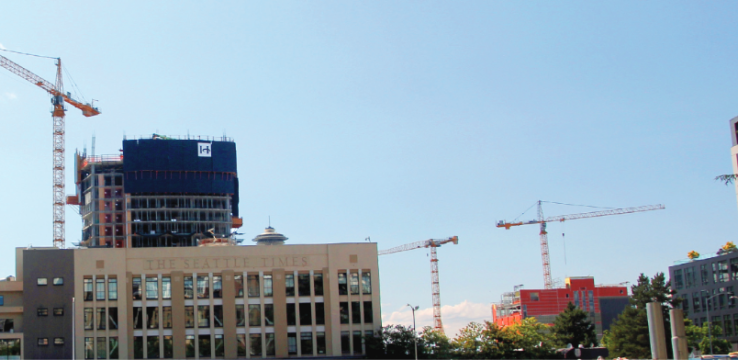"In Seattle, we have a provisional social license to build in the urban core.”
— Gene Duvernoy
This statement, made by the director of Forterra, a regional advocacy organization in the Puget Sound, neatly sums up a striking difference in culture and policy between Seattle and San Francisco. There is no such license in the Bay Area. Here, the public antipathy (anxiety? angst?) toward growth — and its codification in our policies and processes — is so pervasive that we scarcely notice it. But in Seattle, not only is infill development happening at a remarkable pace, it is happening with a great deal less opposition, anxiety, conflict and delay. Seattle looks a lot like San Francisco. It’s a diverse, hot-market city with abundant jobs, progressive values and a beautiful natural context. Rents are rising. Traffic is worsening. But the response has been drastically different. With more than 20 percent fewer residents, Seattle has consistently produced about double the amount of housing as San Francisco in recent decades. San Franciscans pay twice as much rent and, more revealing, 60 percent more of their incomes on rent. Duvernoy’s statement is carefully qualified: People in Seattle are not uncritical enthusiasts for shiny new buildings. They are, like San Franciscans, watchful and engaged citizens. Conflict abounds, as do familiar concerns about what is being lost as the city grapples with social, economic and physical change.
Rents are rising, and debates about housing policy are ongoing. But with that said, there seems to be a broad recognition that accommodating growth in the right places is far preferable to the alternative. If San Francisco and Seattle have such similar challenges and values, what accounts for the difference in approach? For one, development approvals are much more streamlined. Washington State’s environmental review process does not allow for the open-ended appeals and litigation that are used to kill or delay projects in California, and projects rarely go before elected officials or to the ballot. Even more significantly, Washington State’s 1990 Growth Management Act requires that local zoning and comprehensive plans accommodate each municipality’s share of regional growth, so local planning processes don’t tend to pit local homeowner interests against regional needs. But the policy mechanics are also a reflection of a different cultural attitude about growth, sprawl, urbanism and conservation.In the civic culture and public consciousness of the Puget Sound region, growth in the urban core has long been associated with the preservation of the region’s beloved open space and agricultural land. The state’s Growth Management Act emerged from a broad bipartisan movement to limit sprawl and conserve open space, which it tackles as two sides of the same coin. Forterra’s influential 2005 Cascade Agenda further reinforced this connection, developing a broad regional vision that addressed wild and rural conservation, the fate of small communities and ambitious growth in the urban centers. It praised developers and city officials who are promoting infill, saying, “As conservationists, we will do our part to help them succeed."
In the Bay Area, our considerable achievements in open space and agricultural conservation have not been linked — in policy or in culture — with accommodating growth in the core. In the Bay Area’s discourse on growth, this allows people to oppose new urban housing on “environmental” grounds with a straight face. The results are self-reinforcing. Because new urban development is relatively easy in Seattle, a lot has been built. The benefits of density — walkable neighborhoods with abundant amenities — have been accruing, reinforcing the consensus that the city can change for the better.Meanwhile, observers in Seattle routinely cite San Francisco as a cautionary tale. One Seattle council member memorably referred to the “San Francisco death spiral” to describe how high housing costs feed a cycle of anxieties about growth, demands for fees, exactions and regulations on new development, and in turn further cost increases. People in Seattle feel good about their region and how it’s growing. A recent Forterra survey showed that residents of the Puget Sound region found an optimistic outlook on the region’s identity and direction by three to one, and strong commitment to planning and preparing for growth. Meanwhile, a widely cited Bay Area Council survey found that only 42 percent of Bay Area residents think the region is on the right track, and 40 percent are considering leaving in the next few years. We should not gloss over the challenges Seattle faces — they look a lot like our own, and we have a lot to learn from one another. But Seattle provides a revealing example of a progressive, hot-market city that largely embraces growth and connects it to conservation at a regional scale. So what is that license again? And how do we get one?

